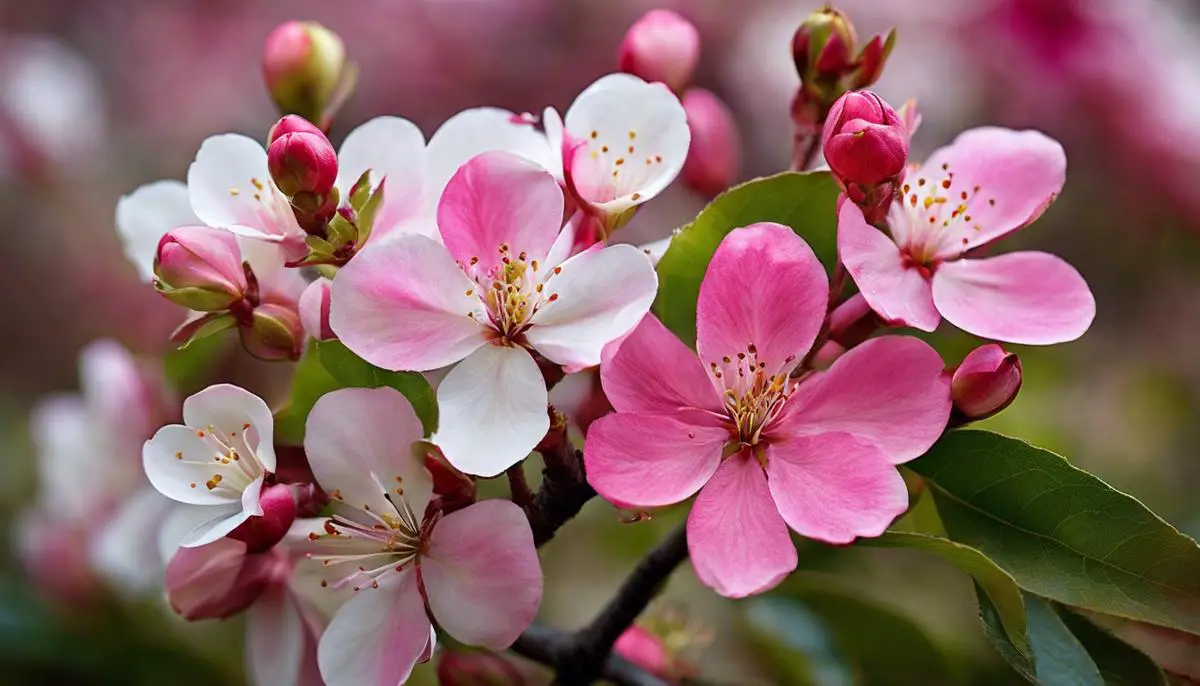Imagine a tree that not only dazzles with its vivacious flowers and lush green leaves but also carries the promise of delicious fruits. This is the allure of the Mexican apple tree, a unique subspecies that thrives in the subtropics. Primarily treasured for their succulent apples, Mexican apple trees are a testament to the wonders of nature and the enticing taste of exotic fruits. Along with understanding this variety’s general features and native habitats, it is also crucial to delve into its growing conditions and care requirements. As we journey into the world of these remarkable trees, we’ll also explore the multifaceted benefits and plentiful uses of their hearty fruits.
Overview of the Mexican Apple Tree
Exploring the Exotic Majesty of the Mexican Apple Tree
Within the myriad of fascinating flora in our world, attention-grabbing species such as the Mexican apple tree, or Malus Mexicana, certainly make quite a remarkable impression. Commonly known as the Texas Crabapple, this engrossing species fascinates hobbyists who are drawn to its hardy nature, attractive blossoms, and tasty fruits.
At first glance, the Mexican apple tree hints at an array of enchanting features that set it apart from other tree species. Standing tall at a height of around 10-30 feet, this tree exhibits a sturdy trunk and an interesting branch system. The branches, adorned with alternate leaves, present a beautiful spectacle, especially during the spring season. The leaves are more or less elliptic, around 1.5-2.5 inches long, with a vibrant green tinge that can bring any landscape to life.
The Mexican apple tree is rathbeck-scale notable for its stunningly fragrant flowers. These flowers, which provide a visual treat from late spring to early summer, exhibit an attractive light pink or white color. For hobbyists interested in beekeeping, these flowers also attract bees, thereby promoting cross-pollination.
Of course, we can’t discuss the Mexican apple tree without mentioning its famous fruits — small crabapples. These fruits, generally appearing in clusters, are yellowish or amber-colored with occasional streaks of red. Apart from their ornamental appeal, these crabapples have a sweet, slightly tangy taste. It should be noted, however, that while sometimes consumed raw, these apples are more commonly used in jellies, preserves, or sauces.
So, where can one find the exotic Mexican apple tree? This marvel of Mother Nature prominently grows in Central Texas, spanning regions like the Edwards Plateau and the Rio Grande Plains. It favors calcareous soil, typically seen in river valleys or near seasonal creeks, showcasing the tree’s preference for thriving under a canopy of larger trees. The species are spotted at elevations between 150-2000 meters, adapting well to environmental variations.
In conclusion, the Mexican apple tree truly is a botanical gem – a hobbyist’s delight. With its compact size, fragrant blossoms, tantalizing fruits, and aesthetic appeal, it’s no wonder this species commands an army of admirers. Given the right conditions and care, this tree promises a spectacular sight, and surely is a must-explore venture for enthusiastic hobbyists.

Growing Conditions for Mexican Apple Trees
As we delve into the wonderful world of the Mexican apple tree, let’s explore the secrets to its successful cultivation. This splendid, rewarding hobby doesn’t just invigorate your green thumbs, but allows for a bountiful harvest – a sweet outcome that’s as gratifying as the gardening process itself!
So, want to know the blueprint to a thriving Mexican apple tree? The answer lies in the subtle art of mirroring its natural habitat, treating the tree with care akin to a cherished family heirloom.
Watering is pivotal. The Mexican apple tree is a fan of consistent hydration, eager for regular watering schedules. However, a good soak does not translate to waterlogging. An optimal balance ensures survival where excessive water pivots to an enemy, making the roots prone to rot.
Soil, the very foundation of any green life, plays a double role in the Mexican apple tree’s life. An ideal soil mixture is well-draining and rich in organic matter, mimicking the tree’s natural habitat. So, loosen the soil with compost, leaf mould, or well-decomposed manure, offering your tree a surfeit of nutrients making way to an unblemished development.
Sunshine – nature’s original magic potion – is just as essential. The Mexican apple tree loves basking in direct sunlight. Ensure it receives at least six hours of solar exposure a day, a rule of thumb firmly upheld by proven growth trends.
Temperature holds significance too. This tropical species despises frost and thrives in regions with warm summers and mild winters. But worry not if you live in a cooler area; the Mexican tree weaves magic indoors too. Cultivate it in a container and bring it inside during frosts.
Insect pests aren’t the best companions. Regularly inspect for pests, such as aphids and scale insects, and give the tree a tender spray if they make an unwelcome appearance. Prevention, in this case, is always better than cure.
Pruning is the cherry on top, promoting air circulation while giving your tree a tidy appearance. Trim away any competing branches, focusing on creating an open canopy. The best time to prune is during the dormant season, post the harvest, thus ensuring hearty blooms in the following year.
Now, that’s a winning formula to a flabbergasting Mexican apple tree! The journey of its cultivation is the reward itself, adding a charm to your garden and a heartening sense of satisfaction to your hobby. Keep nurturing and watching nature take its beautiful course is its own blessing, anywhere, anytime.

Planting and Care Instructions
Starting on the journey of planting and cultivating a Mexican apple tree can be intriguing, especially knowing about its physical characteristics, the fragrant flowers, and the small crabapple fruits that it yields. It’s not just about the enticing appeal it shows, but also the fulfilling process of cultivation. Let’s delve into the nitty-gritty of the successful growth of this lovely flora.
Watering is an integral part of this journey. A steady watering routine is a must as consistent moisture preferably damp but not waterlogged, is critical. Remember, overwatering could lead to root rot, while underwatering can wilt the tree. A balanced approach is vital.
Next is the soil mix. An ideal soil combination involves a fair share of organic matter. It helps boost nutrient levels while improving soil structure. A composite mixture of loam, garden soil, and compost works incredibly well. Organic mulch aids in retaining moisture and controlling weeds.
Sunlight pays a major role too. Providing direct sunlight for at least six hours a day is imperative for the proper growth of a Mexican apple tree. Whenever possible, ensure the tree has an open, sunny space. It aids in the photosynthesis process promoting stronger, healthier growth.
Managing temperature conditions is key. Outdoor planting is suggested until the tree can bear an average frost. However, in profound frost conditions, indoor cultivation is advisable until it passes. Mexican apple tree’s roots are cold-hardy, but the healthy growth of the tree best thrives when above freezing temperatures.
Another area to watch out for is pests. Regular check-ups for insect pests and diseases can save your tree from potential threats. Safe insecticide sprays, organic remedies, and pest control treatments can help you go a long way in keeping your tree healthy.
Pruning is another beneficial practice for a Mexican apple tree. It encourages air circulation, keeping the tree disease-free, and maintains a tidy appearance. Early spring is often the best time for pruning this tree, allowing fresh growth in the warmer season.
Beyond these essential points, patience and watchfulness play key roles too. Planting a Mexican apple tree is much more than a hobby; it’s a rewarding journey entailing a fair share of adventure and satisfaction. So, brace yourself and dive in! With the right care and attention, you can look forward to a healthy, vibrant tree, enhancing your garden’s appeal while providing a host of benefits itself.

Benefits and Uses of Mexican Apples
Now, let’s delve into the heart of the matter – the myriad health benefits of Mexican apples and how to incorporate them into our everyday lives.
Packed with essential nutrients and antioxidants, these small fruits can play a significant role in enhancing our overall health.
The Mexican apple, known as “tejocote,” is rich in vitamins A and C, linked to improved eye health, a stronger immune system, and faster wound healing.
Consuming these apples regularly might just be the helping hand your immunity needs! Plus, vitamin A in these crabapple fruits supports our vision, especially in a low light setting.
Iron is another mineral in abundance in Mexican apples. A crucial component of hemoglobin, iron helps supply oxygen to all parts of the body, ensuring organs function efficiently and enhancing overall health stamina.
Here’s a fun fact – these apples may even help keep anemia at bay, thanks to its iron content!
Famously, Mexican apples burst with pectin, a type of dietary fiber found in apple skins.
This fiber benefits digestion, helps control blood sugar levels, and may even contribute towards reducing bad cholesterol – an all-rounder indeed!
Beyond delivering these fantastic health benefits, the Mexican apple is virtually a versatile fruit.
Its tart flavor makes it an interesting addition to a range of recipes.
Tejocote can be used in homemade jams and jellies for a unique taste and added nutritional boost.
Traditional Mexican dishes, such as the popular “ponche navideño,” often include these apples for an exciting twist.
To incorporate this superfood into your daily meals, try mixing diced Mexican apples into your morning oatmeal or tossing some into your favorite salad for a bit of tart goodness.
Don’t let their small size fool you – Mexican apples can make a big difference in your daily nutrition and wellness when used regularly.
In addition to the fruit, Tejocote root is used in various nutritional supplements for weight loss.
However, always consult a healthcare provider before starting any new supplement regimen.
Unveiling the health benefits of Mexican apples lets us appreciate this unusual fruit more, right?
Just a reminder, owning a Mexican apple tree requires time and care.
But bear in mind; the rewards of enjoying homegrown, nutritious fruit are well worth the effort!
Happy planting, growing, cooking, and of course, eating with the magical Mexican apple – truly a wonder of nature’s bounty.

With its vibrant display of nature’s artistries and the scrumptiousness of its fruits, the Mexican apple tree captures the heart of every gardening expert and enthusiast. Whether you’re fascinated by its visual appeal, enticed by the prospect of freshly picked apples, or intrigued by their myriad health benefits and culinary uses, there’s always something exciting to learn and enjoy about these trees. Planting and taking good care of a Mexican apple tree can bring a symphony of taste, aesthetics, and wellness into your life. And even beyond their array of personal benefits, these trees carry the timeless charm of nature’s gifts – a charm that remains alive in every leaf, flower, and fruit they bear.